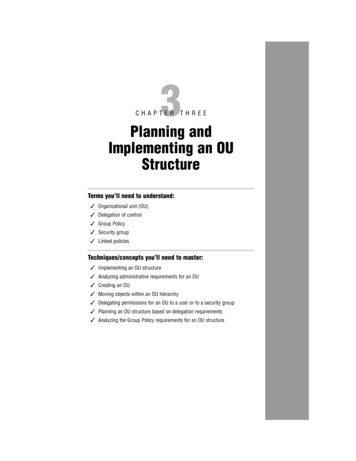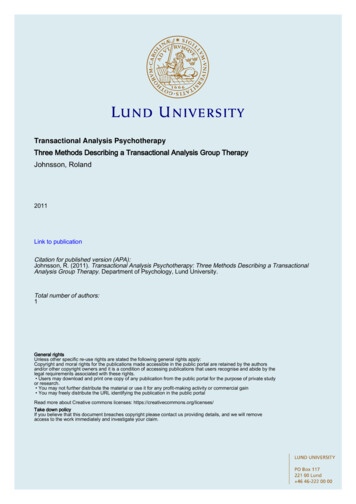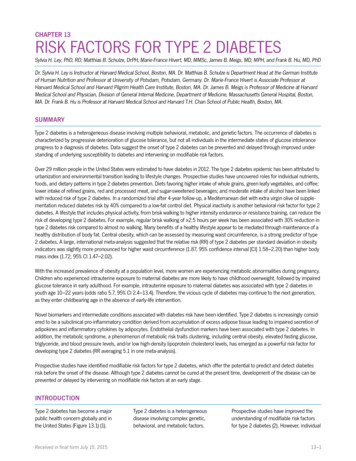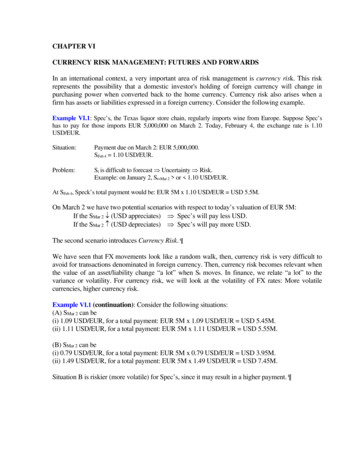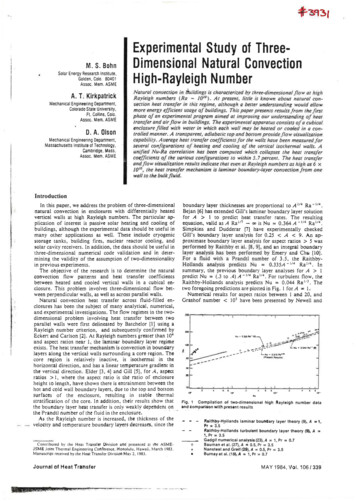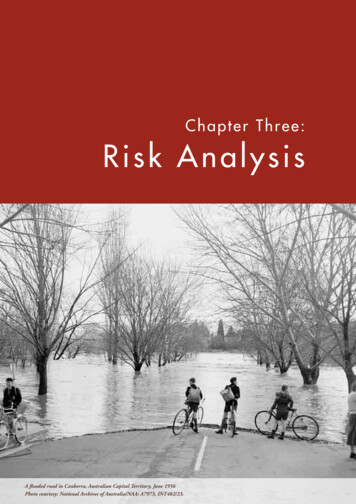
Transcription
Chapter Three:Risk AnalysisLightningA flooded road in Canberra, Australian Capital Territory, June 1956PhotoMeteorologyPhoto courtesy:courtesy: BureauNationalofArchivesof Australia/NAA: A7973, INT482/23.
Risk AnalysisRisk analysis involves developing an understandingof risk, which is an important step in the riskmanagement process, and provides the foundationupon which informed decisions on mitigation maybe based. Analysing risk allows priority areas to betargeted for mitigation and can assist in the allocationof limited resources. Risk analysis may thereforeplay an important role in cost–benefit studies, whichcompare the costs of a particular action or projectagainst its potential benefits.This chapter provides an overview of risk analysis,with a particular focus on assessing the componentsof likelihood and consequence. Three factorswhich contribute to risk—hazard, exposure andvulnerability—are introduced.Building damage following an earthquake in Newcastle,New South Wales, December 1989Photo courtesy: Geoscience Australia.State Emergency Service volunteers remove a tree from a rooffollowing storm damage, New South Wales, January 1991Photo courtesy: Emergency Management Australia.A destroyed house following a bushfire on the Eyre Peninsula,South Australia, January 2005Photo courtesy: Geoscience Australia.State Emergency Service flood rescue boat used to transportfodder to stranded stock, northeast Victoria, October 1993Photo courtesy: Emergency Management Australia.p a g e 3 2 N AT U R A L H A Z A R D S I N A U S T R A L I A Identifying Risk Analysis Requirements
A ‘hazard’ refers to a single event or series of eventswhich is characterised by a certain magnitudeand likelihood of occurrence. ‘Exposure’ refersto the elements that are subject to the impact ofa specific hazard, such as houses on a floodplain.‘Vulnerability’ is the degree to which the exposedelements will suffer a loss from the impact of ahazard. These terms are described in further detaillater in this chapter. The reader is also referred tothe glossary for definitions of key terms.Figure 3.1 portrays risk as a triangle. Thearea inside the triangle represents risk andthe sides of the triangle represent the threeindependent factors that contribute to risk:hazard, exposure and vulnerability in equal07-2175-7POSUEXHAZARDFigure 3.1: The risk triangleSource: Crichton (1999), Figure 3.ESTABLISH THE CONTEXTRiskAssessmentIDENTIFY RISKSANALYSE RISKSMONITOR AND REVIEWCOMMUNICATE AND CONSULTRisk in disaster management has been describedby Crichton (1999) as the probability of a loss,which depends on three factors: hazard, exposureand vulnerability.RISKTY‘the chance of something happening that willhave an impact on objectives. A risk is oftenspecified in terms of an event or circumstanceand the consequences that may flow from it.Risk is measured in terms of a combinationof the consequences of an event and theirlikelihood.’‘Likelihood’ describes how often a hazard islikely to occur, and is commonly referred toas the probability or frequency of an event.‘Consequence’ describes the effect or impactof a hazard on a community. Both likelihoodand consequence may be expressed using eitherdescriptive words (i.e. qualitative measures) ornumerical values (i.e. quantitative measures) tocommunicate the magnitude of the potentialimpact (AS/NZS 4360:2004).ILIABERLNVUMany definitions of ‘risk’ exist (Kelman 2003;Thywissen 2006). Risk is defined by the riskmanagement standard AS/NZS 4360:2004 as(p. 4):proportions. Changing any one of the threecomponents changes the amount of risk.RERiskEVALUATE RISKSTREAT RISKS06-1365-9Figure 3.2: Risk management processSource: AS/NZS 4360:2004, Figure 2.1.Risk Management ProcessThe risk management standard AS/NZS4360:2004 provides a framework for managingthe risk posed by hazards. The broad steps involvedin the risk management process as outlined in thestandard are shown in Figure 3.2.Risk Analysis Chapter Three page 33
Damage caused by a bushfire on the Kings Tablelands, Blue Mountains, New South Wales, December 2006Photo courtesy: Will Barton Photography.The steps include: establish the context, identifyrisks, analyse risks, evaluate risks and treat risks.Throughout each step of the risk managementprocess, it is essential to communicate andconsult with stakeholders, and monitor andreview the process. The steps in the shadedsubsection—identify risks, analyse risks andevaluate risks—form the risk assessment process.As AS/NZS 4360:2004 is generic, individualdisciplines and persons have tailored individualsections to suit their areas of expertise andresponsibility. For example, EmergencyManagement Australia (EMA) has developed adetailed risk management process for emergencymanagement (EMA 2004), and the AustralianGeomechanics Society (AGS 2007) has developedguidelines for landslide risk management.The reader is referred to AS/NZS 4360:2004 andits companion guide HB 436:2004 for furtherinformation on the steps in the risk managementprocess.Risk AnalysisThis report focuses on the third step in the riskmanagement process, risk analysis, as defined byAS/NZS 4360:2004 (p. 4):‘the systematic process to understand the natureof and to deduce the level of risk. It providesthe basis for risk evaluation and decisionsabout risk treatment.’The type of risk analysis varies dependingon the situation being considered. This issuccinctly described in the standard AS/NZS4360:2004 (p. 18):‘Risk analysis may be undertaken to varyingdegrees of detail depending upon the risk, thepurpose of the analysis, and the information,data and resources available. Analysis may bequalitative, semi-qualitative or quantitativeor a combination of these, depending on thecircumstances.’A risk analysis is usually conducted to identifyadverse consequences, although it may alsobe used proactively to identify and prioritisepotential opportunities (AS/NZS 4360:2004).Risk Evaluation CriteriaThe development of a set of risk evaluation criteriaagainst which risk levels and the effectiveness ofsuggested treatment strategies can be measuredis one component of establishing the context,the first step of the risk management process(AS/NZS 4360:2004). Developing risk criteriarequires decisions to be made on specificallywhich risks are to be evaluated, and may bebased on any number of types of criteria, such ashumanitarian, social, environmental, operationaland financial.The risk analysis should be consistent with therisk evaluation criteria established up front. Thep a g e 3 4 N AT U R A L H A Z A R D S I N A U S T R A L I A Identifying Risk Analysis Requirements
evaluation criteria against which the level ofrisk is assessed will play a part in defining themethods used to analyse risk (HB 436:2004).Important evaluation criteria which shouldbe considered are: the consequences that willbe addressed (e.g. number of people killed orinjured), how likelihood will be defined (e.g.qualitatively or quantitatively), and how it willbe determined whether the risk level is such thatfurther treatment activities are required (HB436:2004).Setting the evaluation criteria will also focus therisk analysis. For example, if the priority is toprotect human life before considering economicloss, an economic analysis should take secondplace. Setting the evaluation criteria also assistsin defining levels of risk acceptance.Examples of possible risk criteria for managingthe impact of natural hazards include establishingthe tolerable number of fatalities and injuries, andthe tolerable number of damaged or destroyedpublic infrastructure assets and facilities orprivate assets. ‘Tolerable risk’ is described in thehandbook HB 436:2004 as (p. 65):‘The concept of tolerable risk derives fromSir Frank Layfield who in 1987 noted that‘although acceptable risk is often used inbalancing risks and benefits it does notadequately convey the reluctance with whichpossibly substantial risks and benefits may betolerated.’ Thus individuals are prepared to‘tolerate’ some risks under certain circumstancesin return for specified benefits.’Other examples include criteria related toimpacts on cultural heritage and the naturalenvironment, or the long-term impact on thelocal economy. An example of the developmentof specific criteria along these lines as part of amulti-hazard risk assessment is the report on riskmanagement for Newcastle, New South Wales(Institute for International Development 2007).Risk FactorsAn understanding of three factors—hazard,exposure and vulnerability—which contribute torisk is vital in determining the potential impactor consequence of a hazard on a community orsociety. The hazard has been described by EMAas (1998, p. 59):‘a source of potential harm or a situation witha potential to cause loss. It may also be referredto as a potential or existing condition that maycause harm to people or damage to property orthe environment.’A hazard may affect different places independentlyor in combination. Some hazards are influencedby seasonal weather conditions. Hazards mayalso vary in duration, intensity and severity(some examples are provided in Chapter 2).Exposure refers to ‘the elements that are subjectto the impact of a specific hazard’ (Middelmannand others 2005, p. 1). The elements at risk aredescribed by EMA as (2004, p. 48):‘the population, buildings and civil engineeringworks, economic activities, public services andinfrastructure, etc. exposed to sources of risk.’The elements at risk may be divided intotangible, intangible and institutional elements(Granger 2007). Examples of tangible elementsinclude people, buildings and infrastructurerelated to power and water supply. Examples ofintangible elements include heritage, personalmemorabilia and community relationships.Both tangible and intangible elements arediscussed further in Chapter 2.Institutional elements include aspects suchas the capacity to share information and theeffectiveness of emergency management plansand coordination arrangements. However,institutional elements are rarely consideredproperly, because of sensitivities.Risk Analysis Chapter Three page 35
Any number and range of elements can beconsidered. The more elements at risk considered,the more comprehensive the risk analysis.For a more rigorous assessment of risk,information on the vulnerability of the elementsat risk to a particular hazard is required. Asfor risk, there are numerous definitions forvulnerability (e.g. Brooks 2003; Handmer andothers 2007; Villagrán 2006). Two definitionsare provided below:‘the degree of susceptibility and resilience ofthe community and environment to hazards’(COAG 2004, p. 104).‘The characteristics of a person or group interms of their capacity to anticipate, cope with,resist, and recover from the impact of a naturalhazard. It involves a combination of factorsthat determine the degree to which someone’slife and livelihood is put at risk by a discreteand identifiable event in nature or in society’(Blaikie and others 1994, p. 9).Risk analysis, as defined in this report, focusesprimarily on biophysical vulnerability which isexperienced by the elements at risk as a result ofan encounter with a hazard (Adger and others2004). Biophysical vulnerability models aim todetermine the impact of a hazard on the elementsat risk, such as people, buildings, infrastructureand the economy.Social vulnerability considers a person and/orsociety’s inherent characteristics, such as social,economic and political background. Socialvulnerability can be viewed independently ofa hazard, as it refers to the characteristics ofindividuals which are shaped by the processesaround them. For example, the loss of a housein a bushfire would not affect all individuals inthe same way. This is because their situations aredifferent, and their access to support networkssuch as family, friends and the community aredifferent. The ability of individuals to recoverfinancially from disaster also varies greatly.Destruction caused by Tropical Cyclone Tracy in Darwin, Northern Territory, December 1974Photo courtesy: Bureau of Meteorology.p a g e 3 6 N AT U R A L H A Z A R D S I N A U S T R A L I A Identifying Risk Analysis Requirements
A definition of vulnerability focused towardsocial vulnerability is (Twigg 2001a, p. 2):demonstrates the integration of buildingvulnerability models and economic models.‘vulnerability is the human dimension ofdisasters. To understand what makes peoplevulnerable, we have to move away from thehazard itself to look at a much wider, anda much more diverse, set of influences: thewhole range of economic, social, cultural,institutional, political and even psychologicalfactors that shape people’s lives and create theenvironment that they live in.’A notable example where biophysicalvulnerability has been combined with socialvulnerability is the ‘hazards-of-place’ modeldeveloped by Cutter and others (2000).Another is the development of combinations ofgeophysical parameters and census demographicdata by Granger (2001).The difference between biophysical vulnerabilityand social vulnerability is described by Adgerand others (2004, p. 30):‘In summary, biophysical vulnerability is afunction of the frequency and severity (orprobability of occurrence) of a given type ofhazard, while social or inherent vulnerabilityis not. A hazard may cause no damage if itoccurs in an unpopulated area or in a regionwhere human systems are well adapted to copewith it.’There is a tendency for researchers to focuson only one aspect of vulnerability, dependingon their expertise. Engineers tend to focus onbuilding vulnerability models incorporatingconsiderations such as structural type, buildinguse, building codes and engineering assessment(Douglas 2007; Dale and others 2004).Economists develop models focusing on economiclosses and the impact of government expenditureon recovery and mitigation options to reduce risk(Mullaly and Wittwer 2006). Social scientistsfocus on people, communities, access to se
AS/NZS 4360:2004 (p. 4): ‘the systematic process to understand the nature of and to deduce the level of risk. It provides the basis for risk evaluation and decisions about risk treatment.’ The type of risk analysis varies depending on the situation being considered. This is succinctly described in the standard AS/NZS 4360:2004 (p. 18): ‘Risk analysis may be undertaken to varying degrees .


